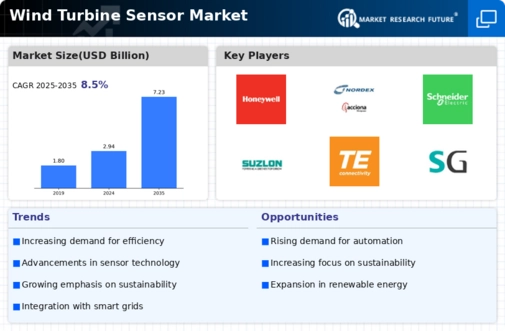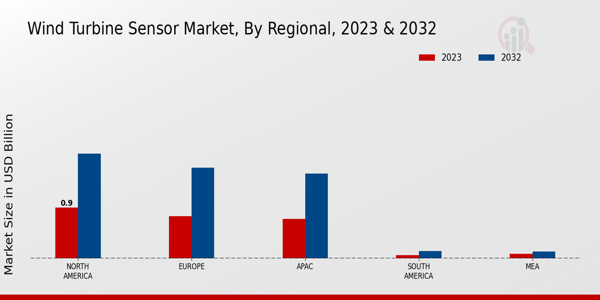Market Growth Projections
The Global Wind Turbine Sensor Market Industry is poised for remarkable growth, with projections indicating a market value of 2.94 USD Billion in 2024 and an anticipated increase to 7.23 USD Billion by 2035. This growth trajectory suggests a compound annual growth rate of 8.52% from 2025 to 2035. The expansion of the market is driven by various factors, including technological advancements, increasing demand for renewable energy, and supportive government policies. As the industry evolves, the integration of innovative sensor technologies will likely play a crucial role in enhancing the efficiency and reliability of wind energy systems.
Rising Demand for Renewable Energy
The increasing global emphasis on renewable energy sources drives the Global Wind Turbine Sensor Market Industry. Governments worldwide are implementing policies to reduce carbon emissions, leading to a surge in wind energy projects. For instance, in 2024, the market is projected to reach 2.94 USD Billion, reflecting the growing investment in wind energy infrastructure. This trend is likely to continue as countries aim to meet their renewable energy targets, potentially resulting in a market value of 7.23 USD Billion by 2035. The integration of advanced sensors in wind turbines enhances efficiency and reliability, further propelling market growth.
Government Initiatives and Incentives
Government initiatives and incentives play a pivotal role in shaping the Global Wind Turbine Sensor Market Industry. Many countries are offering financial support and tax incentives to promote the adoption of wind energy technologies. For example, various nations have established feed-in tariffs and renewable energy certificates, encouraging investments in wind turbine installations. These supportive policies not only stimulate market growth but also foster innovation in sensor technologies. As a result, the market is poised for substantial expansion, with projections indicating a market value of 2.94 USD Billion in 2024 and a potential increase to 7.23 USD Billion by 2035.
Growing Focus on Predictive Maintenance
The growing focus on predictive maintenance within the wind energy sector significantly influences the Global Wind Turbine Sensor Market Industry. By utilizing advanced sensors, operators can monitor turbine performance and predict potential failures before they occur. This proactive approach reduces maintenance costs and enhances turbine reliability, ultimately leading to increased energy production. The trend towards predictive maintenance is expected to drive market growth, as companies seek to optimize their operations. The anticipated compound annual growth rate of 8.52% from 2025 to 2035 underscores the importance of this strategy in the evolving landscape of wind energy.
Increasing Investment in Wind Energy Projects
The increasing investment in wind energy projects is a critical driver of the Global Wind Turbine Sensor Market Industry. As countries strive to diversify their energy portfolios, substantial funding is directed towards the development of wind farms. This influx of capital not only supports the installation of new turbines but also necessitates the integration of advanced sensor technologies for monitoring and optimization. The market is projected to grow from 2.94 USD Billion in 2024 to 7.23 USD Billion by 2035, reflecting the robust investment climate. This trend indicates a strong commitment to renewable energy and the essential role of sensors in enhancing operational efficiency.
Technological Advancements in Sensor Technology
Technological innovations in sensor technology significantly impact the Global Wind Turbine Sensor Market Industry. The development of advanced sensors, such as IoT-enabled devices, allows for real-time monitoring and predictive maintenance of wind turbines. These advancements enhance operational efficiency and reduce downtime, which is crucial for maximizing energy output. As the market evolves, the adoption of smart sensors is expected to increase, contributing to a compound annual growth rate of 8.52% from 2025 to 2035. This growth reflects the industry's commitment to leveraging technology for improved performance and sustainability.














